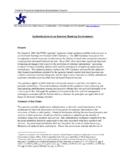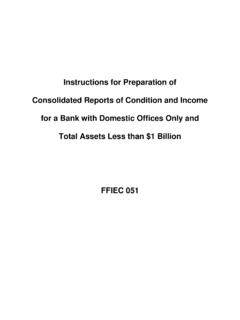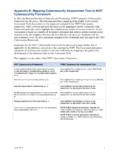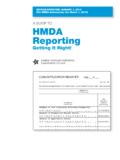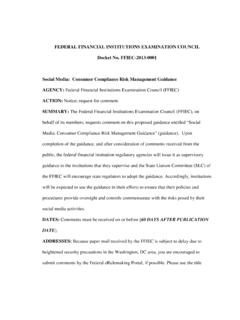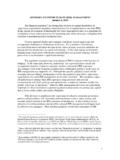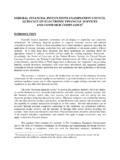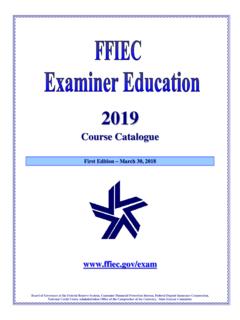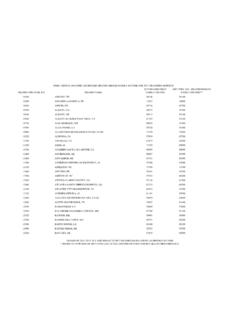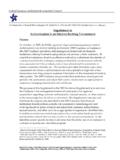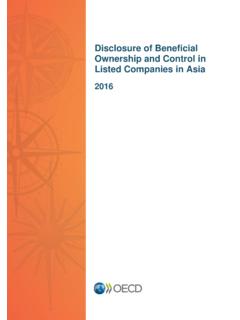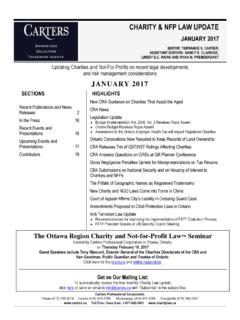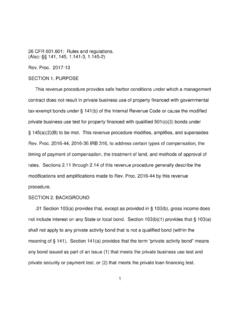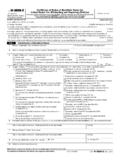Transcription of Guidance FIN-2016-G003 Issued: July 19, 2016 …
1 Guidance FIN- 2016 -G003 Issued: July 19, 2016 Subject: Frequently Asked Questions Regarding Customer Due Diligence Requirements for Financial Institutions _____ Frequently Asked Questions (FAQs) Question 1: Purpose of CDD Rule Q: Why is FinCEN issuing the CDD Rule? A. FinCEN is issuing the CDD Rule to amend existing BSA regulations in order to clarify and strengthen customer due diligence requirements for certain financial institutions. The CDD Rule outlines explicit customer due diligence requirements and imposes a new requirement for these financial institutions to identify and verify the identity of beneficial owners of legal entity customers, subject to certain exclusions and exemptions.
2 Within this construct, as stated in the preamble to the Rule, FinCEN intends that the legal entity customer identify its ultimate beneficial owner or owners and not nominees or straw men. Question 2: Rule application Q: Does the CDD Rule apply to all financial institutions? A: No. The CDD Rule applies to covered financial institutions. The Financial Crimes Enforcement Network ( FinCEN ) is issuing these FAQs to assist covered financial institutions in understanding the scope of the Customer Due Diligence Requirements for Financial Institutions, published on May 11, 2016 (the CDD Rule ), available at These FAQs provide interpretive Guidance with respect to the CDD rule.
3 FinCEN intends to issue additional FAQs or Guidance as appropriate. 2 Question 3: Covered financial institutions Q: Which financial institutions are covered under the CDD Rule? A: For purposes of the CDD Rule, covered financial institutions are federally regulated banks and federally insured credit unions, mutual funds, brokers or dealers in securities, futures commission merchants, and introducing brokers in Question 4: CDD requirements for covered financial institutions with respect to beneficial ownership Q: What are the requirements for covered financial institutions to collect beneficial ownership information?
4 A: The CDD Rule requires covered financial institutions to establish and maintain written procedures that are reasonably designed to identify and verify the beneficial owners of legal entity customers. These procedures must enable the institution to identify the beneficial owners of each customer at the time a new account is opened, unless the customer is otherwise excluded or the account is exempted. Also, the procedures must establish risk-based practices for verifying the identity of each beneficial owner identified to the covered financial institution, to the extent reasonable and practicable.
5 The procedures must contain the elements required for verifying the identity of customers that are individuals under applicable customer identification program ( CIP ) In short, covered financial institutions are now required to obtain, verify, and record the identities of the beneficial owners of legal entity customers. Question 5: Amendments to the anti-money laundering ( AML ) program requirements Q: Are there any changes to the AML program requirements for covered financial institutions in the Rule? A: Yes. The CDD Rule amends the AML program requirements for each covered financial institution to explicitly require covered institutions to implement and maintain appropriate risk-based procedures for conducting ongoing customer due diligence, to include: understanding the nature and purpose of the customer relationships; and conducting ongoing monitoring to identify and report suspicious transactions and, on a risk basis, to maintain and update customer information.
6 A covered financial institution s AML program must include, at a minimum: (1) a system of internal controls; (2) independent testing; (3) designation of a compliance officer or individual(s) responsible for day-to-day compliance; (4) training for appropriate personnel; and (5) appropriate risk-based procedures for conducting ongoing CDD to understand the nature and 1 Covered financial institution is defined at 31 CFR (e)(1). 2 See 31 CFR (a)(2), 31 CFR (a)(2), 31 CFR , and 31 CFR (a)(2) for applicable CIP requirements.
7 3 purpose of customer relationships and to conduct ongoing monitoring to identify and report suspicious transactions, and, on a risk basis, to maintain and update customer information. Question 6: Procedures for identification and verification of identity of beneficial owners Q: Must a covered financial institution s procedures for identifying and verifying the identity of beneficial owners of legal entity customers be identical to its customer identification program? A: No. However, the CDD Rule requires that the procedures, at a minimum, contain the same elements as required for verifying the identity of customers that are individuals under the applicable CIP rule.
8 However, financial institutions may use photocopies or other reproductions of identification documents in the case of documentary verification. Question 7: Anti-money laundering procedures Q: Are covered financial institutions required to include the procedures for identifying and verifying the identity of the beneficial owners of legal entity customers in the institution s AML compliance program? A: Yes. The CDD procedures must be included in the covered financial institution s AML compliance program. Question 8: Collection of beneficial ownership information Q: Are covered financial institutions required to collect any information about beneficial ownership from the legal entity customer?
9 A: Yes. Covered financial institutions must collect information on individuals who are beneficial owners of a legal entity customer in addition to the information they are required to collect on the customer under the CIP requirement. Question 9: Definition of beneficial owner Q: Who is a beneficial owner? A: The Rule defines beneficial owner as each of the following: each individual, if any, who, directly or indirectly, owns 25% or more of the equity interests of a legal entity customer ( , the ownership prong); and a single individual with significant responsibility to control, manage, or direct a legal entity customer, including an executive officer or senior manager ( , a Chief Executive Officer, Chief Financial Officer, Chief Operating Officer, Managing Member, General Partner, President, Vice President, or Treasurer).
10 Or any other individual who regularly performs similar functions ( , the control prong). This list of positions is illustrative, not exclusive, as there is significant diversity in how legal entities are structured. 4 Under this definition, a legal entity will have a total of between one and five beneficial owners ( , one person under the control prong and zero to four persons under the ownership prong). Question 10: Collection of information for beneficial owners Q: Are covered financial institutions required to obtain information directly from the beneficial owners of legal entity customers?
